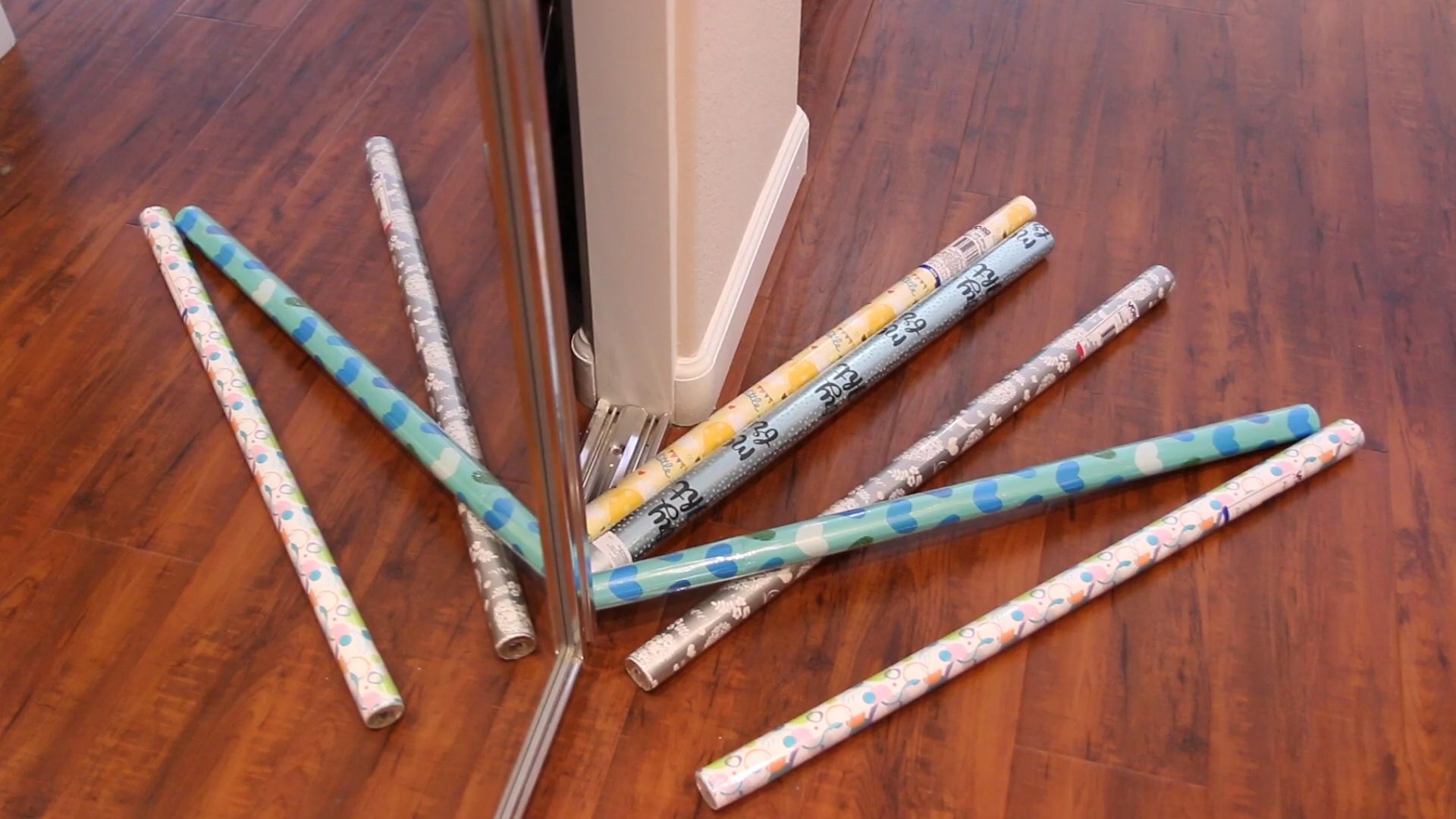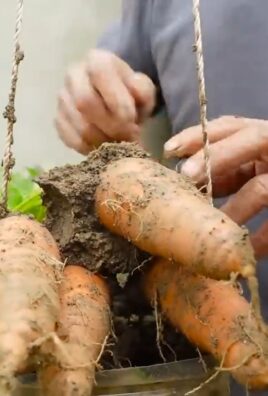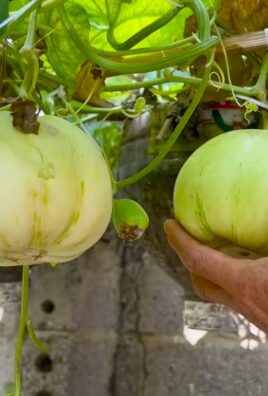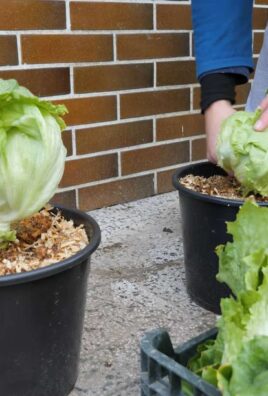Grow Lemongrass at Home and transform your kitchen into a fragrant, flavorful paradise! Have you ever dreamt of snipping fresh lemongrass straight from your garden for your Thai curries or soothing teas? It’s easier than you think, and this DIY guide will show you exactly how to make that dream a reality.
Lemongrass, with its vibrant citrusy aroma, has been a staple in Asian cuisine and traditional medicine for centuries. Originating in Southeast Asia, it’s revered not only for its culinary uses but also for its potential health benefits, from aiding digestion to acting as a natural insect repellent. I’ve always been fascinated by its versatility and the ease with which it can be incorporated into daily life.
But why should you bother learning to grow lemongrass at home? Well, for starters, think of the money you’ll save on buying it from the grocery store! Plus, homegrown lemongrass is often fresher and more flavorful than anything you can find commercially. More importantly, in a world increasingly concerned with sustainability and knowing where our food comes from, cultivating your own lemongrass offers a rewarding connection to nature and a sense of self-sufficiency. This DIY project is perfect for anyone looking to add a touch of the exotic to their garden or balcony, and I’m excited to share my tried-and-true methods with you!

Grow Your Own Lemongrass: A Beginner’s Guide
Hey there, fellow plant enthusiasts! Ever dreamed of having fresh, fragrant lemongrass right at your fingertips? Well, dream no more! Growing lemongrass at home is surprisingly easy, and I’m here to guide you through every step of the process. Trust me, once you’ve tasted homemade lemongrass tea or added it to your favorite Asian dishes, you’ll never want to be without it.
What You’ll Need
Before we dive in, let’s gather our supplies. Don’t worry, you probably have most of these things lying around already!
* Lemongrass stalks: You can find these at most Asian grocery stores or even some well-stocked supermarkets. Look for stalks that are firm, green at the top, and have a bulbous base.
* A glass or jar: Tall enough to hold the lemongrass stalks upright.
* Water: Tap water is fine!
* Potting soil: A well-draining potting mix is essential.
* A pot: Choose a pot that’s at least 12 inches in diameter to give your lemongrass plenty of room to grow.
* Optional: Rooting hormone: This can help speed up the rooting process, but it’s not strictly necessary.
* Optional: Fertilizer: A balanced liquid fertilizer will give your lemongrass a boost.
Section 1: Rooting Your Lemongrass Stalks
This is the most crucial step, so pay close attention! We’re essentially tricking the lemongrass into thinking it’s time to grow roots.
1. Prepare the Stalks: First, trim the top of the lemongrass stalks, leaving about 4-5 inches of green. This helps the plant focus its energy on root development. Remove any dry or brown outer leaves from the base of the stalk. You want to expose the fresh, healthy part of the stalk that will eventually sprout roots.
2. Water Propagation: Fill your glass or jar with about 2-3 inches of water. Place the lemongrass stalks in the water, making sure the base of the stalks is submerged. Don’t overcrowd the jar; give each stalk some space.
3. Location, Location, Location: Place the jar in a warm, sunny location. A windowsill that gets plenty of sunlight is ideal. Lemongrass loves warmth and light!
4. Water Changes: Change the water every 2-3 days to keep it fresh and prevent bacteria from growing. This is super important for healthy root development.
5. Patience is Key: Now comes the waiting game. It usually takes about 2-3 weeks for roots to start appearing. You’ll see small white roots emerging from the base of the stalks. Be patient! Sometimes it takes a little longer, depending on the variety of lemongrass and the environmental conditions.
6. Root Check: Once the roots are about 2-3 inches long, your lemongrass is ready to be planted in soil! This is a really exciting moment!
Section 2: Planting Your Rooted Lemongrass
Now that your lemongrass has roots, it’s time to give it a permanent home in a pot.
1. Prepare the Pot: Fill your pot with well-draining potting soil, leaving about an inch of space at the top.
2. Create a Hole: Make a hole in the center of the pot that’s large enough to accommodate the roots of your lemongrass.
3. Gently Plant: Carefully remove the lemongrass stalk from the water and gently place it in the hole. Make sure the roots are spread out and not crammed together.
4. Cover the Roots: Fill the hole with potting soil, gently pressing down around the base of the stalk to secure it.
5. Water Thoroughly: Water the newly planted lemongrass thoroughly until water drains out of the bottom of the pot. This helps settle the soil and ensures the roots are well-hydrated.
6. Sunlight is Your Friend: Place the pot in a sunny location. Lemongrass needs at least 6 hours of sunlight per day to thrive.
Section 3: Caring for Your Lemongrass
Now that your lemongrass is planted, it’s time to learn how to keep it happy and healthy.
1. Watering: Lemongrass loves water, so keep the soil consistently moist, but not soggy. Water deeply whenever the top inch of soil feels dry to the touch. During hot summer months, you may need to water it more frequently.
2. Fertilizing: Feed your lemongrass with a balanced liquid fertilizer every 2-3 weeks during the growing season (spring and summer). This will help it grow strong and healthy. Follow the instructions on the fertilizer label.
3. Pruning: As your lemongrass grows, you can harvest the stalks as needed. To harvest, simply cut off the stalks near the base of the plant. This will encourage new growth. You can also trim away any brown or dead leaves to keep the plant looking tidy.
4. Overwintering: Lemongrass is a tropical plant and doesn’t tolerate frost. If you live in a cold climate, you’ll need to bring your lemongrass indoors during the winter. Place it in a sunny location and water it less frequently. You can also try wrapping the pot with burlap to provide extra insulation.
5. Pest Control: Lemongrass is generally pest-resistant, but occasionally it can be affected by aphids or spider mites. If you notice any pests, you can try spraying the plant with insecticidal soap or neem oil.
Section 4: Harvesting and Using Your Lemongrass
The best part about growing your own lemongrass is being able to harvest it whenever you need it!
1. When to Harvest: You can start harvesting lemongrass stalks when they are about 1/2 inch in diameter and at least 12 inches tall.
2. How to Harvest: Use a sharp knife to cut the stalks near the base of the plant.
3. Using Fresh Lemongrass: Fresh lemongrass can be used in a variety of dishes, including soups, curries, stir-fries, and teas. To use it, simply bruise the stalk to release its flavor and aroma. You can also chop it finely and add it directly to your dishes.
4. Drying Lemongrass: If you have more lemongrass than you can use, you can dry it for later use. To dry lemongrass, simply hang the stalks upside down in a cool, dry place until they are completely dry. You can then store them in an airtight container.
5. Making Lemongrass Tea: One of my favorite ways to use fresh lemongrass is to make tea. Simply steep a few bruised lemongrass stalks in hot water for 5-10 minutes. Add honey or lemon to taste. It’s so refreshing and delicious!
Troubleshooting
Even with the best care, sometimes things can go wrong. Here are a few common problems and how to fix them:
* Yellowing Leaves: This could be a sign of overwatering or underwatering. Check the soil moisture and adjust your watering accordingly. It could also indicate a nutrient deficiency, so try fertilizing your plant.
* Slow Growth: This could be due to insufficient sunlight or lack of nutrients. Make sure your lemongrass is getting at least 6 hours of sunlight per day and fertilize it regularly.
* No Root Development: If your lemongrass isn’t rooting, try changing the water more frequently and make sure it’s in a warm, sunny location. You can also try using rooting hormone to speed up the process.
Final Thoughts
Growing lemongrass at home is a rewarding experience that will add a touch of freshness and flavor to your life. With a little patience and care, you’ll be enjoying your own homegrown lemongrass in no time! Happy gardening!

Conclusion
So, there you have it! Growing lemongrass at home is not only achievable, but it’s also incredibly rewarding. Forget those wilted, overpriced stalks at the grocery store. Imagine stepping into your garden or onto your balcony and harvesting fresh, fragrant lemongrass whenever you need it. The vibrant citrusy aroma alone is enough to justify the effort, but the culinary possibilities are truly endless. From Thai curries and Vietnamese pho to refreshing teas and invigorating cocktails, your homegrown lemongrass will elevate your dishes to a whole new level.
This DIY trick is a must-try because it offers a sustainable and cost-effective way to access a key ingredient in many Asian cuisines. It’s also a fantastic way to reduce your carbon footprint by minimizing your reliance on commercially grown and transported produce. Plus, let’s be honest, there’s something deeply satisfying about nurturing a plant from a simple stalk to a thriving herb.
Beyond the basic method we’ve outlined, there are plenty of ways to customize your lemongrass growing experience. Consider experimenting with different varieties of lemongrass, such as the East Indian or West Indian types, to discover your preferred flavor profile. You can also explore different container sizes and materials to optimize growth in your specific climate and space. For those living in colder regions, consider bringing your potted lemongrass indoors during the winter months to ensure a continuous supply. Another variation is to use the lemongrass leaves to make a refreshing tea. Simply steep a few chopped leaves in hot water for a few minutes, and enjoy the soothing and aromatic beverage. You can also add ginger or honey for extra flavor.
Don’t be intimidated by the process. Even if you’re a novice gardener, growing lemongrass at home is surprisingly straightforward. With a little patience and attention, you’ll be harvesting your own supply in no time. We encourage you to give this DIY project a try and experience the joy of growing your own fresh herbs.
We’re confident that you’ll be delighted with the results. And once you’ve mastered the art of growing lemongrass, we’d love to hear about your experience! Share your tips, tricks, and photos with us in the comments below. Let’s build a community of lemongrass enthusiasts and inspire others to embrace the joys of homegrown herbs. What are you waiting for? Get started on your lemongrass growing journey today!
Frequently Asked Questions (FAQ)
What kind of lemongrass should I buy to start growing?
When purchasing lemongrass stalks to propagate, look for healthy-looking stalks with a bulbous base and firm, green leaves. Avoid stalks that are wilted, discolored, or show signs of damage. Ideally, purchase organic lemongrass to avoid any potential pesticide residue. You can typically find lemongrass at Asian grocery stores or well-stocked supermarkets. The key is to find stalks that still have their roots attached, or at least the potential for roots to grow.
How long does it take for lemongrass to root in water?
Generally, it takes about 2-4 weeks for lemongrass to develop roots in water. The exact timeframe can vary depending on factors such as water temperature, light exposure, and the overall health of the lemongrass stalks. Change the water every few days to keep it fresh and prevent the growth of bacteria. Be patient, and you’ll soon see tiny roots emerging from the base of the stalks.
What is the best type of soil for growing lemongrass?
Lemongrass thrives in well-draining soil that is rich in organic matter. A loamy soil mix is ideal. You can create your own potting mix by combining equal parts of potting soil, compost, and perlite or vermiculite. This will provide the necessary nutrients and drainage for healthy growth. Avoid heavy clay soils, as they can retain too much moisture and lead to root rot.
How much sunlight does lemongrass need?
Lemongrass requires at least 6-8 hours of direct sunlight per day to thrive. Choose a sunny location in your garden or on your balcony where your lemongrass will receive ample sunlight. If you’re growing lemongrass indoors, place it near a south-facing window or supplement with a grow light. Insufficient sunlight can result in weak, leggy growth and reduced flavor.
How often should I water my lemongrass plant?
Water your lemongrass plant regularly, especially during hot and dry weather. The soil should be kept consistently moist, but not waterlogged. Water deeply whenever the top inch of soil feels dry to the touch. Reduce watering during the winter months when the plant is dormant. Overwatering can lead to root rot, so be sure to provide adequate drainage.
How do I harvest lemongrass?
To harvest lemongrass, use a sharp knife to cut the stalks near the base of the plant. You can harvest individual stalks as needed, or harvest the entire plant at once. When harvesting, select the thicker, more mature stalks first. After harvesting, remove the outer leaves and use the tender inner core in your cooking. You can also dry the leaves for use in teas or potpourri.
Can I grow lemongrass in a container?
Yes, lemongrass grows very well in containers. Choose a pot that is at least 12 inches in diameter to allow for adequate root growth. Make sure the pot has drainage holes to prevent waterlogging. Use a well-draining potting mix and place the container in a sunny location. Container-grown lemongrass may require more frequent watering than lemongrass grown in the ground.
How do I overwinter lemongrass in cold climates?
Lemongrass is a tropical plant and is not frost-tolerant. If you live in a cold climate, you’ll need to overwinter your lemongrass indoors. Before the first frost, dig up your lemongrass plant and pot it in a container. Cut back the foliage to about 6 inches. Place the container in a cool, bright location, such as a sunroom or greenhouse. Water sparingly during the winter months, allowing the soil to dry out slightly between waterings. In the spring, after the last frost, you can gradually acclimate your lemongrass plant to outdoor conditions and replant it in your garden.
What are some common problems with growing lemongrass?
Some common problems with growing lemongrass include root rot, pests, and nutrient deficiencies. Root rot can occur if the soil is too wet or poorly drained. To prevent root rot, ensure that your lemongrass plant is growing in well-draining soil and avoid overwatering. Pests such as aphids and spider mites can sometimes infest lemongrass plants. To control pests, you can spray your plants with insecticidal soap or neem oil. Nutrient deficiencies can cause yellowing or stunted growth. To prevent nutrient deficiencies, fertilize your lemongrass plant regularly with a balanced fertilizer.
Can I propagate lemongrass from seed?
While it is possible to grow lemongrass from seed, it is generally more difficult and time-consuming than propagating from stalks. Lemongrass seeds can be difficult to germinate, and the resulting plants may not be as vigorous as those grown from stalks. If you do choose to grow lemongrass from seed, start the seeds indoors in early spring. Sow the seeds in a well-draining seed starting mix and keep them moist until they germinate. Once the seedlings are large enough to handle, transplant them into individual pots and grow them on until they are ready to be planted outdoors.




Leave a Comment